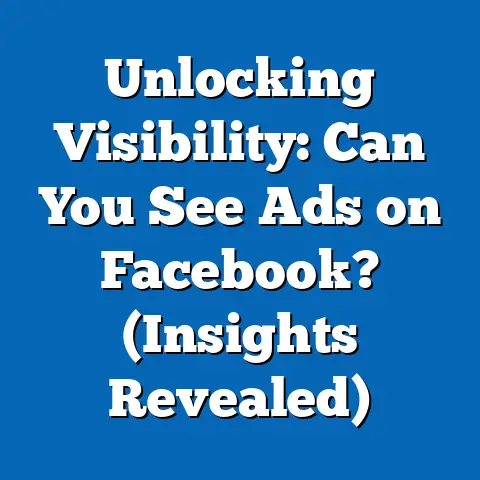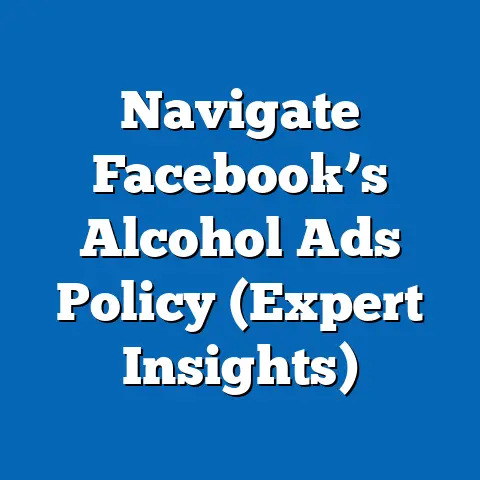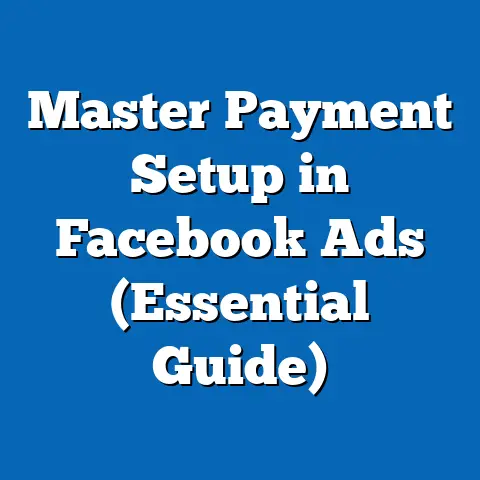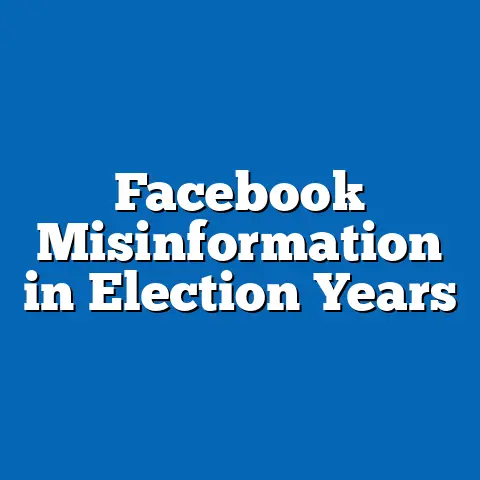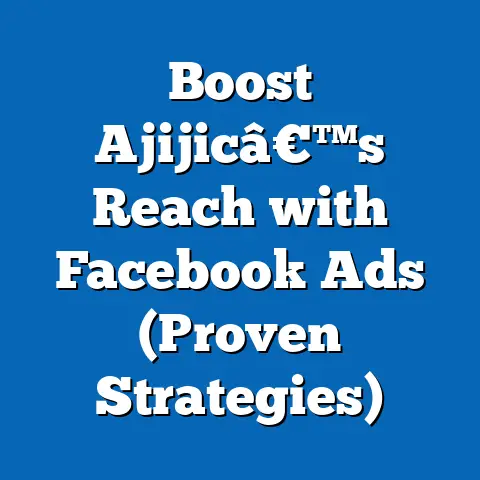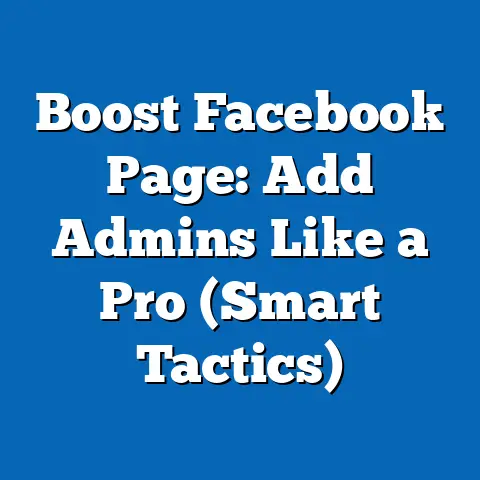Adsense vs Facebook Ads: The Ultimate Showdown (Expert Insights)
In today’s digital age, online advertising is the lifeblood of countless businesses, big and small. It’s how we reach new customers, build brand awareness, and ultimately, drive sales. Two giants dominate this landscape: Google AdSense and Facebook Ads. Both offer incredible potential, but understanding their strengths and weaknesses is crucial for maximizing your marketing ROI.
What I’ve learned over the years is that while both platforms are powerful, their true potential lies in their customizability. The ability to tailor your campaigns – from targeting the perfect audience to crafting compelling ad creatives – is what truly sets successful advertisers apart. So, let’s dive into the ultimate showdown between AdSense and Facebook Ads, exploring their unique features, benefits, and how you can leverage them to achieve your advertising goals. I’ll also share my personal experiences and insights to help you navigate the often-complex world of online advertising.
Google AdSense: A Publisher’s Perspective
Google AdSense is, at its core, a program that allows website owners and content creators to earn revenue by displaying targeted advertisements on their sites. It’s a symbiotic relationship: advertisers pay Google to display their ads, and Google shares a portion of that revenue with the publishers who host the ads.
A Brief History and Purpose: AdSense launched in 2003, quickly becoming a game-changer for online publishing. Before AdSense, monetizing website traffic was often a complex and time-consuming process, requiring direct sales efforts and individual agreements with advertisers. AdSense democratized the process, allowing anyone with a website and quality content to participate in the advertising ecosystem.
Ad Formats and Placements: AdSense offers a variety of ad formats, including:
- Text Ads: Simple, text-based ads that blend seamlessly with the surrounding content.
- Image Ads: Visually appealing ads that use images or graphics to capture attention.
- Video Ads: Engaging video ads that can be displayed in various formats, such as in-stream or in-banner.
These ads can be placed in various locations on your website, including:
- Header and Footer: Common placements for banner ads.
- Sidebar: Ideal for displaying ads alongside your content.
- Within Content: Ads strategically placed within your articles or blog posts for maximum visibility.
Targeting Capabilities: AdSense offers several targeting options to ensure that the ads displayed on your website are relevant to your audience:
- Contextual Targeting: This is where AdSense really shines. Google’s algorithms analyze the content of your pages and display ads that are related to the topic. For example, a blog about cooking might display ads for kitchen appliances or recipe books.
- Demographic Targeting: You can also target ads based on the demographics of your audience, such as age, gender, and location.
Expert Insight: I’ve seen firsthand how effective contextual targeting can be. I once worked with a small business that sold organic gardening supplies. By using AdSense on their blog, which featured articles about gardening tips and techniques, they were able to reach a highly targeted audience of potential customers, resulting in a significant increase in sales.
Key Takeaway: Google AdSense is a powerful tool for website owners looking to monetize their content. Its ease of use and contextual targeting capabilities make it an excellent option for generating passive income.
Facebook Ads: Connecting with Your Audience
Facebook Ads, on the other hand, is a platform designed to help businesses reach their target audience on Facebook, Instagram, and other platforms within the Meta ecosystem. It’s a dynamic and highly targeted advertising solution that offers a wide range of ad formats and placements.
A Look at its Evolution: Facebook Ads has evolved significantly since its inception. Initially, it was a relatively simple platform with basic targeting options. However, as Facebook’s user base grew and its data collection capabilities improved, Facebook Ads became increasingly sophisticated, offering advertisers unprecedented control over their campaigns.
Ad Formats and Placements: Facebook Ads offers a diverse range of ad formats to suit different marketing objectives:
- Image Ads: Single image ads that are perfect for showcasing products or services.
- Video Ads: Engaging video ads that can be used to tell stories, demonstrate products, or build brand awareness.
- Carousel Ads: Ads that allow you to display multiple images or videos in a single ad unit, ideal for showcasing a range of products or features.
- Collection Ads: Ads that feature a main image or video along with a selection of related products, designed to drive sales directly from the ad.
- Instant Experience Ads: Full-screen, mobile-optimized ads that offer an immersive and interactive experience for users.
These ads can be placed in various locations across the Meta ecosystem, including:
- News Feed: The most common placement for Facebook Ads, appearing directly in users’ feeds alongside organic content.
- Instagram Feed: Similar to the News Feed, ads appear in users’ Instagram feeds.
- Stories: Short-form, vertical video ads that appear in users’ Stories on Facebook and Instagram.
- Messenger: Ads that appear in users’ Messenger inboxes.
- Audience Network: Ads that are displayed on third-party websites and apps that are part of Facebook’s Audience Network.
Advanced Targeting Options: Facebook Ads is renowned for its advanced targeting capabilities, allowing advertisers to reach incredibly specific audiences:
- Interest-Based Targeting: Target users based on their interests, hobbies, and activities.
- Demographic Targeting: Target users based on their age, gender, location, education, and other demographic factors.
- Behavioral Targeting: Target users based on their online behavior, such as their purchase history, website visits, and app usage.
- Lookalike Audiences: Create audiences that are similar to your existing customers, allowing you to reach new potential customers who are likely to be interested in your products or services.
- Retargeting: Target users who have previously interacted with your website or app, such as those who have visited specific pages or added items to their cart.
Expert Insight: I’ve seen businesses achieve remarkable results with Facebook Ads by leveraging lookalike audiences. By uploading a list of their existing customers, they were able to create a lookalike audience that mirrored the characteristics of their best customers, resulting in a significant increase in conversions.
Key Takeaway: Facebook Ads is a powerful platform for reaching highly targeted audiences and driving a variety of marketing objectives, from brand awareness to lead generation to sales. Its advanced targeting options and diverse ad formats make it a versatile tool for businesses of all sizes.
Customizability Comparison: Taking Control of Your Campaigns
When it comes to online advertising, the ability to customize your campaigns is paramount. It’s the key to reaching the right audience, delivering the right message, and ultimately, achieving your marketing goals. Let’s compare the customizability of AdSense and Facebook Ads:
AdSense Customizability:
- Ad Placement: You have control over where ads are placed on your website, but the specific ads that are displayed are determined by Google’s algorithms.
- Ad Styles: You can customize the appearance of your ads to match the look and feel of your website, but you have limited control over the creative content of the ads themselves.
- Blocking Categories: You can block certain categories of ads from appearing on your website, but you cannot target specific interests or demographics.
Facebook Ads Customizability:
- Ad Creative: You have complete control over the creative content of your ads, including the images, videos, and text.
- Audience Targeting: You can target incredibly specific audiences based on a wide range of demographic, interest-based, and behavioral factors.
- Campaign Objectives: You can choose from a variety of campaign objectives, such as brand awareness, lead generation, website traffic, and sales, and optimize your ads accordingly.
- Bidding Strategies: You can choose from a variety of bidding strategies, such as automatic bidding, manual bidding, and cost-per-click bidding, to control your ad spend.
Expert Opinion: In my experience, Facebook Ads offers significantly more customizability than AdSense. The ability to target specific audiences, create compelling ad creatives, and optimize your campaigns for specific objectives gives you a level of control that is simply not possible with AdSense.
Case Study: I worked with a local bakery that wanted to promote its new line of gluten-free products. Using Facebook Ads, we were able to target users who had expressed an interest in gluten-free diets, healthy eating, and local bakeries. We created visually appealing ads that showcased the bakery’s gluten-free products and offered a special discount for first-time customers. As a result, the bakery saw a significant increase in sales of its gluten-free products.
Key Takeaway: While AdSense offers some level of customization, Facebook Ads provides far greater control over your campaigns, allowing you to target specific audiences, create compelling ad creatives, and optimize your ads for specific objectives.
Performance Metrics and ROI: Measuring Success
Measuring the performance of your advertising campaigns is crucial for understanding what’s working, what’s not, and how to optimize your efforts for maximum ROI. Let’s analyze the key performance metrics associated with AdSense and Facebook Ads:
AdSense Performance Metrics:
- Page RPM (Revenue Per Mille): The estimated earnings you accrue for every 1,000 page views.
- Click-Through Rate (CTR): The percentage of users who click on your ads.
- Ad Impressions: The number of times your ads are displayed on your website.
- Estimated Earnings: The total revenue you’ve earned from AdSense.
Facebook Ads Performance Metrics:
- Reach: The number of unique users who saw your ads.
- Impressions: The number of times your ads were displayed.
- Click-Through Rate (CTR): The percentage of users who clicked on your ads.
- Cost Per Click (CPC): The average cost you paid for each click on your ads.
- Conversion Rate: The percentage of users who completed a desired action, such as making a purchase or filling out a form.
- Return on Ad Spend (ROAS): The revenue generated for every dollar spent on advertising.
Comparing Effectiveness:
- Traffic: Both platforms can drive traffic to your website, but Facebook Ads is generally more effective for driving targeted traffic.
- Lead Generation: Facebook Ads is a powerful tool for generating leads, thanks to its advanced targeting options and lead generation ad formats.
- Sales: Both platforms can drive sales, but Facebook Ads is often more effective for driving direct sales, especially for e-commerce businesses.
Expert Insight: I’ve found that ROAS is the most important metric to track for Facebook Ads campaigns. It provides a clear picture of how much revenue you’re generating for every dollar you spend, allowing you to optimize your campaigns for maximum profitability.
Research Finding: According to a study by HubSpot, the average ROAS for Facebook Ads is $4.30, meaning that for every dollar spent on advertising, businesses generate an average of $4.30 in revenue.
Key Takeaway: Both AdSense and Facebook Ads offer a variety of performance metrics to track the effectiveness of your campaigns. However, Facebook Ads provides more granular data and insights, allowing you to optimize your campaigns for specific objectives and maximize your ROI.
Pros and Cons: Weighing Your Options
Choosing the right advertising platform depends on your specific business needs and advertising goals. Let’s weigh the pros and cons of AdSense and Facebook Ads:
Google AdSense:
Pros:
- Ease of Use: AdSense is relatively easy to set up and manage.
- Passive Income Potential: You can earn revenue passively by displaying ads on your website.
- Contextual Relevance: Ads are automatically targeted to the content of your website.
Cons:
- Limited Customization: You have limited control over the ads that are displayed on your website.
- Low Earning Potential: Earning significant revenue from AdSense can be challenging, especially for websites with low traffic.
- Potential for Low-Quality Ads: Some ads may be irrelevant or of low quality, which can negatively impact your website’s user experience.
Facebook Ads:
Pros:
- In-Depth Targeting: You can target incredibly specific audiences based on a wide range of demographic, interest-based, and behavioral factors.
- Diverse Ad Formats: Facebook Ads offers a variety of ad formats to suit different marketing objectives.
- Community Engagement: You can engage with your audience directly through comments, likes, and shares.
Cons:
- Ad Fatigue: Users may become fatigued by seeing the same ads repeatedly.
- Competition: The Facebook Ads marketplace is highly competitive, which can drive up ad costs.
- Time Commitment: Managing Facebook Ads campaigns effectively requires a significant time commitment.
Expert Perspective: I believe that AdSense is a good option for website owners who want to generate passive income from their content, while Facebook Ads is a better choice for businesses that want to reach highly targeted audiences and drive specific marketing objectives.
When to Choose AdSense:
- You have a website with high-quality content and decent traffic.
- You want to generate passive income without actively managing advertising campaigns.
- You’re not concerned about having complete control over the ads that are displayed on your website.
When to Choose Facebook Ads:
- You want to reach a specific target audience with tailored messages.
- You want to drive specific marketing objectives, such as brand awareness, lead generation, or sales.
- You’re willing to invest the time and resources required to manage Facebook Ads campaigns effectively.
Key Takeaway: AdSense and Facebook Ads are two distinct advertising platforms with their own strengths and weaknesses. The best choice for your business depends on your specific needs, goals, and resources.
Conclusion: Finding the Right Fit
In the ultimate showdown between Google AdSense and Facebook Ads, there’s no clear winner. Both platforms have their unique strengths and weaknesses, making them suitable for different types of advertisers. The key takeaway is that understanding the customizability of each platform is essential for maximizing your advertising ROI.
AdSense is a great option for website owners looking to generate passive income from their content, while Facebook Ads is a powerful tool for businesses that want to reach highly targeted audiences and drive specific marketing objectives.
I encourage you to evaluate your advertising strategies and consider how each platform can fit into your overall marketing plan. Experiment with different ad formats, targeting options, and bidding strategies to find what works best for your business. And remember, continuous monitoring and optimization are essential for achieving long-term success in the ever-evolving world of online advertising.
So, take the insights I’ve shared, apply them to your campaigns, and watch your online advertising efforts soar!

